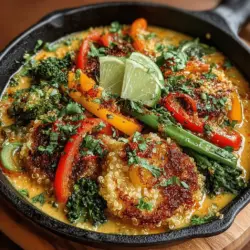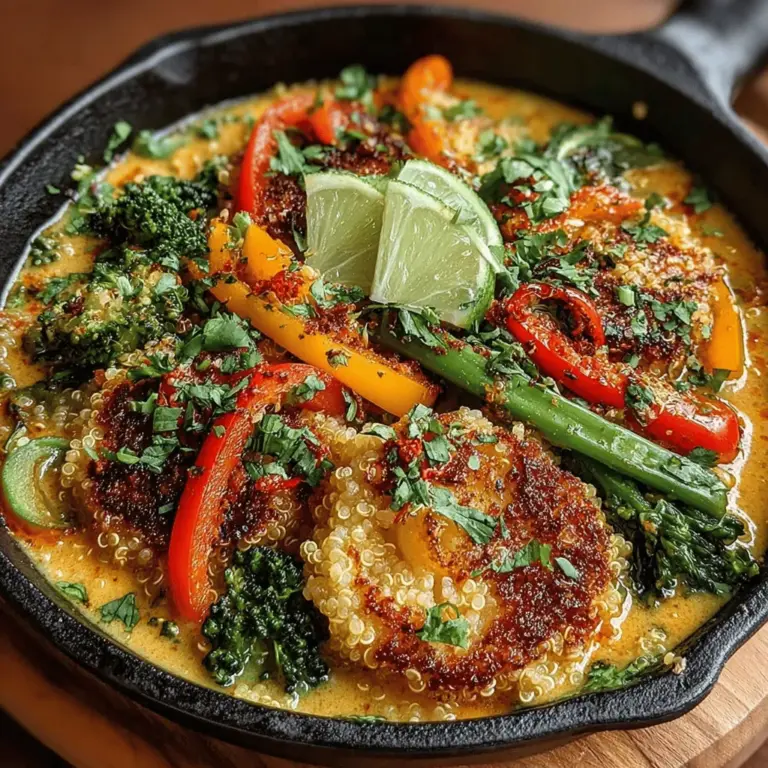Introduction: Discovering the Delight of One-Pot Coconut Curry Quinoa and Veggies
In today’s fast-paced world, finding a meal that is both nourishing and easy to prepare can be a challenge. Enter the One-Pot Coconut Curry Quinoa and Veggies—a vibrant, flavorful dish that encapsulates the essence of comfort food while being packed with nutrients. This recipe not only simplifies cooking by minimizing cleanup, but it also combines the richness of coconut milk with the aromatic spices of curry, creating a satisfying meal that can easily cater to various dietary preferences. Whether you’re a seasoned home chef or a beginner in the kitchen, this dish is sure to impress with its delightful flavors and health benefits.
Ingredients
– 1 cup quinoa, rinsed
– 1 can (13.5 oz) coconut milk
– 2 cups vegetable broth
– 1 medium onion, diced
– 2 cloves garlic, minced
– 1 inch ginger, grated
– 2 tablespoons red curry paste
– 1 teaspoon ground turmeric
– 1 teaspoon ground cumin
– 1 bell pepper, diced (any color)
– 1 cup broccoli florets
– 1 cup snap peas, trimmed
– 1 medium sweet potato, peeled and diced
– 2 tablespoons coconut oil
– Salt and pepper to taste
– Fresh cilantro for garnish (optional)
Instructions
1. Heat the coconut oil in a large pot over medium heat.
2. Add the diced onion and sauté for about 3-4 minutes until it becomes translucent.
3. Stir in the minced garlic and grated ginger, cooking for another 1-2 minutes until fragrant.
4. Mix in the red curry paste, ground turmeric, and ground cumin, ensuring the spices coat the onion mixture evenly.
5. Add the diced bell pepper, sweet potato, broccoli, and snap peas to the pot, stirring well to combine.
6. Pour in the rinsed quinoa, coconut milk, and vegetable broth, stirring to incorporate all ingredients.
7. Season with salt and pepper to taste, then bring the mixture to a boil.
8. Once boiling, reduce the heat to low, cover the pot, and let it simmer for about 20 minutes or until the quinoa is cooked and the sweet potato is tender.
9. Remove from heat and let it sit for 5 minutes before fluffing with a fork. Garnish with fresh cilantro if desired.
Understanding the Ingredients: A Flavorful Foundation
Exploring the Core Ingredients
– Quinoa: The Superfood Grain
Quinoa is a gluten-free grain that is not only versatile but also rich in protein and fiber, making it an ideal base for a healthy meal.
– Coconut Milk: Creaminess and Flavor
Coconut milk adds a luxurious creaminess to the dish along with healthy fats that enhance the overall flavor profile.
– Vegetable Broth: Enhancing the Base
Using vegetable broth enriches the dish with depth, providing a savory backdrop that complements the other ingredients.
Highlighting the Aromatics
– Onion: The Flavor Base
Onion serves as the foundation for many dishes, providing a sweet and savory flavor when sautéed.
– Garlic and Ginger: Aromatic Powerhouses
These ingredients not only enhance the aroma but also contribute health benefits, including anti-inflammatory properties.
Diving into the Spices
– Red Curry Paste: A Spicy Kick
Red curry paste is essential for imparting a spicy and aromatic quality to the dish, making it a standout.
– Turmeric: The Golden Spice
Known for its vibrant color and health benefits, turmeric adds an earthy flavor and acts as a natural anti-inflammatory.
– Ground Cumin: Earthy Depth
Cumin adds a warm, nutty flavor that rounds out the spice profile, enhancing the overall taste of the curry.
Showcasing the Vegetables
– Colorful Bell Peppers: Adding Crunch and Nutrition
Bell peppers provide a crunchy texture and are rich in vitamins A and C, making them a healthy addition.
– Broccoli: A Nutrient-Rich Powerhouse
Broccoli is packed with essential vitamins and minerals, contributing both nutrition and color to the dish.
– Snap Peas: Crisp and Fresh
Snap peas offer a refreshing crunch and are a great source of dietary fiber.
– Sweet Potato: Sweetness and Heartiness
Sweet potatoes add natural sweetness and heartiness, making the dish more filling and satisfying.
Cooking Process: Step-by-Step Instructions for Success
Sautéing the Aromatics
– Melting Coconut Oil: The Starting Point
Starting with coconut oil helps to infuse the dish with a subtle coconut flavor, enhancing the overall taste.
– The Importance of Sautéing Onion, Garlic, and Ginger
Sautéing these aromatics unlocks their flavors, providing a rich base for the curry.
Integrating Spices and Vegetables
– Balancing Flavors: Combining Spices with Fresh Produce
Properly integrating spices with fresh vegetables ensures a balanced flavor throughout the dish.
– Cooking Techniques: Ensuring Even Coating of Spices
Stirring frequently helps to evenly distribute the spices and prevents burning, leading to a more flavorful outcome.
Introducing Grains and Liquids
– Incorporating Quinoa and Broth
Adding quinoa and broth at the right time allows for proper cooking and absorption of flavors, resulting in a delicious and cohesive dish.

Tips for a Flawless Dish
The Role of Quinoa in the Dish
Quinoa serves as the backbone of this recipe, providing a hearty texture and nutty flavor that complements the rich coconut curry. Its ability to absorb flavors makes it a perfect canvas for the spices and vegetables, ensuring each bite is a delightful experience. When selecting quinoa, opt for organic varieties for the best quality and flavor.
Importance of Liquid Ratios: Achieving the Perfect Texture
Getting the liquid ratios right is crucial when cooking quinoa. A standard ratio is 2:1 (liquid to quinoa), but this can vary based on the other ingredients in your curry. Always keep an eye on the consistency; if the quinoa seems dry, a splash of additional broth or coconut milk can elevate the dish.
Simmering to Perfection
When it comes to cooking quinoa, the simmering process should be gentle. A rapid boil can lead to uneven cooking. Instead, bring the mixture to a boil and then reduce to a simmer, allowing the quinoa to absorb the flavors fully.
Cooking Time: Understanding Quinoa’s Absorption
Quinoa typically takes about 15-20 minutes to cook. It’s essential to monitor the cooking time and taste periodically. This ensures that the quinoa remains fluffy and does not become mushy.
The Art of Low and Slow Cooking
Low and slow cooking allows the flavors to meld beautifully. After the initial cooking phase, letting the dish sit covered for a few minutes off the heat can enhance the flavors and texture even further.
Final Seasoning Touches
Balancing Flavors with Salt and Pepper
Seasoning is key to pulling all the flavors together. Start with a pinch of salt and pepper, but taste as you go. The richness of the coconut milk may require different salt levels than traditional recipes, so adjust accordingly.
Enhancing Freshness with Cilantro
Fresh herbs can brighten up the dish. Adding chopped cilantro just before serving not only enhances the flavor but also adds a pop of color, elevating the visual appeal of your meal.
Serving Suggestions: Making the Most of Your Dish
Plating the Coconut Curry Quinoa
Presentation matters. Serve your Coconut Curry Quinoa in deep bowls to highlight the vibrant colors of the vegetables. A sprinkle of additional cilantro and a few chili flakes can add an inviting touch.
Pairing with Lime Wedges: Adding a Zesty Finish
Offering lime wedges on the side allows guests to add a splash of acidity, balancing the richness of the coconut milk and enhancing the overall flavor profile.
Exploring Variations and Customizations
Protein Additions: Chickpeas, Chicken, or Tofu
Feel free to customize the protein in your dish. Chickpeas offer a plant-based option, while chicken or tofu can add heartiness. Adjust cooking times accordingly to ensure everything is cooked perfectly.
Alternative Vegetables: Tailoring to Seasonal Produce
Incorporating seasonal vegetables not only supports local agriculture but also brings freshness to your dish. Consider adding asparagus in spring or squash in the fall to keep your meals exciting.
Nutritional Benefits: Why This Dish is a Healthy Choice
Highlighting Nutrients in Quinoa
Complete Protein Profile
Quinoa is unique among grains as it provides a complete protein profile, containing all nine essential amino acids. This makes it an excellent choice for vegetarians and vegans looking to meet their protein needs.
High in Fiber
With its high fiber content, quinoa aids in digestion and helps maintain a feeling of fullness, making it a great option for those looking to manage their weight.
Coconut Milk’s Health Benefits
Rich in Healthy Fats
Coconut milk is loaded with medium-chain triglycerides (MCTs), which may help boost metabolism and provide quick energy.
Potential Immunity Boosting Properties
Coconut milk also has anti-inflammatory properties, potentially boosting immunity and supporting overall health.
Vegetable Benefits
Antioxidant-Rich Ingredients
The variety of vegetables in the dish provides a wide array of vitamins, minerals, and antioxidants, contributing to overall health and well-being.
Importance of a Colorful Plate for Nutritional Balance
A colorful plate not only pleases the eye but also indicates a diverse range of nutrients. Aim for a mix of colors to maximize the health benefits of your meal.
Conclusion: Embracing the One-Pot Wonder
The One-Pot Coconut Curry Quinoa and Veggies is not just a recipe; it is an invitation to create a nourishing meal that fits seamlessly into a busy lifestyle. With its vibrant colors and robust flavors, this dish embodies the perfect balance of health and indulgence. As you savor each bite, you’ll appreciate the harmony of spices, the creaminess of coconut, and the wholesome goodness of vegetables. This recipe serves as a testament to the idea that cooking can be both simple and rewarding, making it a staple in your culinary repertoire. Enjoy the journey of preparing and sharing this delightful meal with family and friends.

